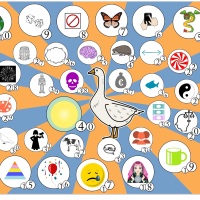“In the early 1970s Lyotard developed a philosophy based around Sigmund Freud’s theory of the libido. For Lyotard, libidinal energy can be used as a “theoretical fiction” to describe the transformations that take place in society. After his break with Marxism and rejection of totalising theory, he sought to develop a theory that will take account of multiple and different forces and desires at work in any political or social situation, from the writing of theory to revolutionary politics to global economics. Lyotard’s libidinal philosophy is developed in the major work Libidinal Economy and in two sets of essays, Dérive à partir de Marx et Freud [some of which is translated in Driftworks] and Des Dispositifs Pulsionnels. Libidinal Economy is an unusual and difficult work, and encompasses a complex set of theories concerning politics, economics, theory, academic style, and readings of Marx and Freud. It is written in a bewildering combination of styles (at times reading more like an avant-garde novel than a philosophical text), a method Lyotard uses in an attempt to overcome the limitations he sees in traditional academic theory.
The libidinal philosophy begins Lyotard’s general commitment to an ontology of events, which also underlies his later postmodern philosophy. Lyotard sees reality in terms of unpredictable happenings (events), rather than structured regularities. These events can be interpreted in different ways, and no single interpretation will capture events accurately. Events always exceed interpretation; there is always something “left over” that an interpretation does not account for. In the libidinal philosophy Lyotard uses the idea of libidinal energy to describe events and the way they are interpreted or exploited, and he develops a philosophy of society and theory in terms of the economy of libidinal energies. Lyotard uses the terms “libidinal intensities,” and “affects” to refer to events. These intensities and affects are, in more common terminology, feelings and desires. In the terms of Freudian psychoanalysis, they are the “primary processes” of the libido, the forces that exist in the body on a more basic level than the “secondary processes” of the conscious mind. In particular, Lyotard focuses on sexual desire. He uses these terms metaphorically, however, to describe the workings of reality and society as a whole, divorcing them from their usual attachments to human beings. Lyotard describes the wholly impersonal as well as the personal in terms of feelings and desires, and paints a picture of the world that moves and is moved in the ways that feelings move people. Lyotard admits that this description of everything in libidinal terms is a “theoretical fiction,” merely a way of speaking which gives us useful terms for theorizing about what happens in the world. Metaphysically, Lyotard is a materialist, and for him affects must be understood as concrete material entities. An affect might be a sound, a color, a smile or a caress: anything which has an ability to “move,” to produce feelings and desires. Affects are structured and interpreted in systems made up of dispositifs, libidinal dispositions or set-ups, and society is composed of multitudes of different dispositions that compete to exploit the energies of libidinal events. Lyotard develops a complex set of figures to describe how this process takes place.
Libidinal Economy begins with the figure of a body (ambivalently sexed), being cut open and spread out to form a flat, band-like surface. Lyotard is here beginning to describe a region on which libidinal intensities take place and on which they meet with the dispositifs that channel libidinal energy. This region is material like the body, but it is not yet organized, thus the figure of dismemberment. The flat band that the body has become is then given a twist and joined end to end, forming a moebius strip (a circular figure which has only one surface due to the twist it contains; a line traced along one side of the strip will end up on the other side without breaking contact with the surface). This strip is then set in motion, circulating so fast it glows red with heat. This is the libidinal band (sometimes called the libidinal skin). It represents the “primary processes” of desire and libidinal intensity in which libidinal energy circulates in an aleatory fashion, not yet investing anything. Because the libidinal band is a moebius strip, desire circulates on only one surface; there is no inside or outside. In time the band begins to slow and cool, and forms what Lyotard calls “the (disjunctive) bar.”
As the bar slows, sometimes it invests this region, sometimes that. It becomes disjunctive, distinguishing this from not-this. This stage in the transformation of the libidinal band represents the formation of rational thought, dominated by binary logic and the law of noncontradiction. Finally the bar stops and forms a stable disjunction. Lyotard describes the bar as then turning around on itself and creating an enclosed space, a theatrical volume. This is the particular transformation of the libidinal band – or the particular dispositif on the libidinal band – that gives rise to representation and theory. The theatrical space has an inside and an outside, a clear disjunction between this and not-this. Lyotard’s image of theory as theatre is based on the etymological relationship between the two terms; they are both derived from the Greek theasthai, meaning to look at, contemplate, or behold. The theorist is like a spectator who views the representation of the world (outside the theatre) on the stage (inside the theatre).
Lyotard’s description of the transformations of the libidinal band is a theoretical fiction which provides an account of how the world works through the interplay of intense, excited libidinal energies and the stable structures which exploit them and dampen their intensity. The band is the space on which libidinal intensities meet dispositifs, or libidinal set-ups. These set-ups channel energy into more or less stable systems and structures, and therefore all dispositifs, all systems and structures, can be described in terms of the slowing and cooling of the band. An example would be the way political institutions channel desires to change society away from violent, disruptive eruptions towards more moderate, less disruptive modes of action. Systems exploit libidinal intensities by channeling them into stable structures. And yet, these systems deny their own origins in intense and aleatory libidinal energy, taking themselves to be permanent and stable. Systems hide, or dissimulate, affects (libidinal intensities). Conversely, however, affects dissimulate systems. Systems and affects dissimulate each other. This means that systems contain and hide affects, and that affects contain and hide the possibility for forming systems. Dissimulation is a concept that allows us to see the elements of the libidinal economy as duplicitous. That is, they have more than one possibility. It is always possible for intensities to channel into a stable system, or to disrupt a system by destabilising it through intense investment.
Lyotard develops a critical but nuanced approach towards theory, politics and economics within the terms of the libidinal philosophy. His prime concern is that the structures that exploit libidinal intensities tend to become hegemonic. That is, they tend to claim sole right to the exploitation or interpretation of intensities. At the same time, they often deny libidinal intensities themselves, taking themselves to be primary and stable structures. Lyotard sees these tendencies as limiting and nihilistic, in the sense that they deny the full possibilities of the expression of intensities. In theory, politics, and cultural conventions, structured dispositions take themselves to be the actual structures of reality or “correct” interpretations, thus limiting the possibilities of change. For Lyotard change is life affirming, whereas the stable structures that inhibit change are nihilistic and life denying. However, Lyotard does not simply assert libidinal intensity as an affirmative “other” to nihilism. For Lyotard, there is no affirmative region, no pure outside to nihilism. Lyotard does not propose that we champion affects, singularities, intensities and libidinal energy over systems, structures, theory, concepts and representation. This is because the only way libidinal energies can exist is within structures. Lyotard does not advocate a simple liberation of desire and does not attempt to set up a place beyond representation which would be immune to the effects of nihilism. Lyotard presents us, rather, with a metaphysical system in which intensities and structures are both essential elements of the libidinal economy.
Lyotard’s response to the nihilism of structure takes place through the concept of dissimulation, which suggests that libidinal energy must work within structures. All structures contain libidinal energy as an under-exploited potentiality, waiting to be released and to flow into new structures. This libidinal energy is the event, which always contains more possibilities for interpretation and exploitation than any single structure can give it. Lyotard’s libidinal philosophy prescribes a “freeing up” of structures, so that events may be allowed their maximum potentiality of expression in competing interpretations and dispositions. Releasing the energy in structures in turn creates new events, with their own energetic potentialities. Because the event is unpredictable, we cannot actively control the way it will be released and form new structures. However, we can “act passively” so as to encourage the maximum release of intensity within structures. Lyotard’s own style of writing in Libidinal Economy is one attempt to do this: by multiplying genres of discourse, there is no overall dominant structure in the text and it is open to several competing modes of reading, interpretation and application. Ultimately, libidinal philosophy suggests a method of subversion from within existing structures through experimentation with the forms of those structures.” (tratto da Internet Encyclopedia of Philosophy)
*Il copyright delle opere linkate appartiene ai rispettivi autori. Citandola in questa pagina ci si avvale del principio del fair dealing in quanto la diffusione che ne viene fatta è a fini di critica, recensione, informazione e insegnamento e non ha scopi economici. Gli autori possono comunque e in qualunque momento richiederne la rimozione.





















